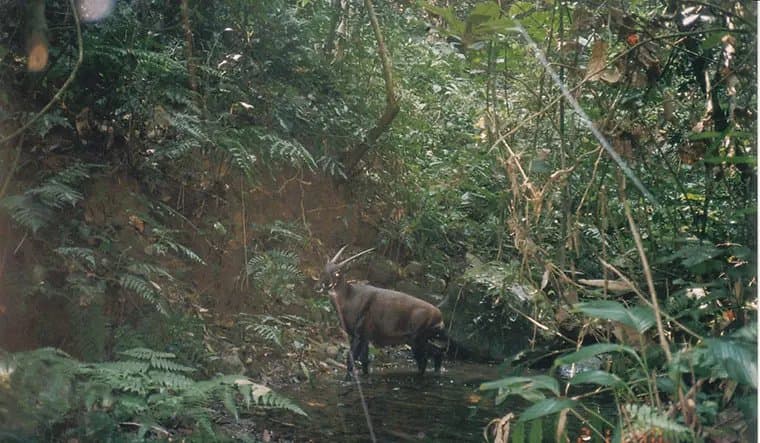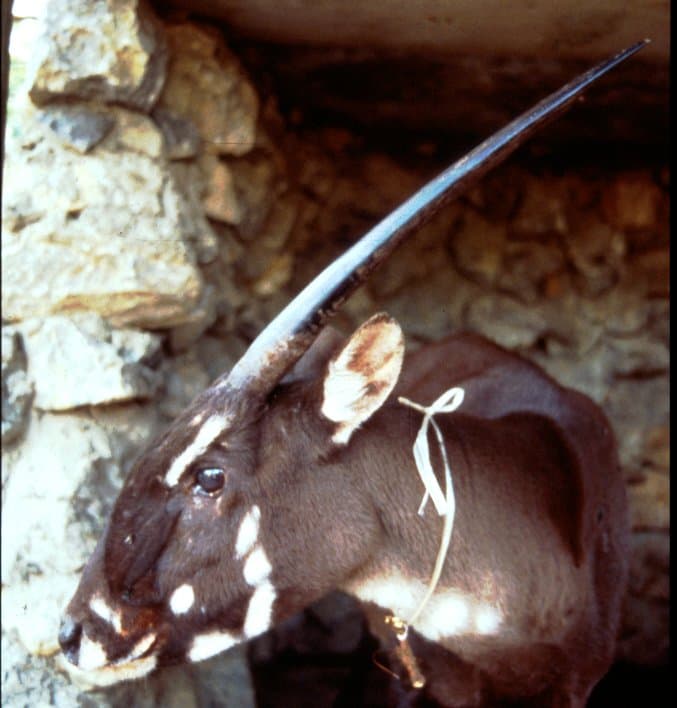Saola Profile
It’s not often a new large animal is discovered. Far more frequently, we hear of animals either going extinct, or reaching the very limits of their viable populations.
So when an elusive bovid was found, new to science, in the forests of Vietnam in 1992, it was great news. Still, the Spindlehorn, or Saola, was found very late in the game and is in desperate need of protection.
The saola (pronounced, ‘sow-la’) is antelope-like, and lives in the forests and river valleys of the Annamite Range in Vietnam and Laos. They are nicknamed the ‘Asian unicorn’, due to their incredibly long horns and exceptional rarity.

Saola Facts Overview
| Habitat: | Wet evergreen forests |
| Location: | Eastern Southeast Asia: Vietnam, Laos |
| Lifespan: | Unknown |
| Size: | Around 1m (3.2 ft) tall, 1.5m (5 ft) length |
| Weight: | Unknown |
| Color: | Dark brown, white stripes on the face |
| Diet: | Herbivorous |
| Predators: | Humans |
| Top Speed: | Unknown |
| No. of Species: |
1 |
| Conservation Status: |
Critically Endangered |
The saola is classified under the family Bovidae, and is the only species of their genus. This is because they differ significantly from others in their family – in both appearance and morphology.
Saola measure up to around 1m in height, and 1.5m in length and have a chocolate brown coat with patches of white on their face. They have a black dorsal stripe and two long horns, that researchers have witnessed they use in defence when threatened.
As saola are so rare and so far none have been kept in captivity for longer than a couple of weeks at a time, much of what we know is from local people.
It’s believed they are generally solitary creatures, but can come together in small groups. They are active during both day and night, and are herbivores – dieting on plants, shrubs and leaves.
Very little information is known about saolas behaviour, due to their rarity and ability to evade researchers almost entirely.
Sadly, this talent is its downfall and coupled with our inability to keep even a single individual alive in captivity, time is running out for this newly-discovered forest bovid which is classified as critically endangered by the IUCN.
Interesting Saola Facts
1. Saola are the first large mammal new to science in over 50 years
Only found in the Annamite Mountains of Vietnam and Laos, saolas were only recently discovered in 1992.
A survey team from the Ministry of Forestry, Vietnam were examining biodiversity in the national park, when they were provided a strange skull with long, pointed horns from a local hunter.
The first photograph of a living saola came a year later in captivity in 1993
2. Their horns are twice the length of their head
Studies suggest their horns measure beteween 35–50 cm in length, and are generally black or dark brown in color.
Both male and female saola have horns. The name ‘saola’ translates to “spindle-horned” in reference to their appearance of parallel wooden posts used locally to support a spinning wheel.

3. It’s estimated that there are no more than 750 remaining
And it’s likely that there the total population is a lot lower than this. The number of saola subpopulations is estimated at somewhere between 6 and 15, with each containing no more than 50 individuals.
These are incredibly elusive and rare animals at the best of times (hence their recent discovery) but with their native habitats shrinking and becoming fragmented, they’re almost impossible to survey with any accuracy.
There are only five reliable recordings of a saola in the wild, and even local populations report sightings of saola significantly less than those of other ungulates in the area. In Laos, there may be fewer than 100 remaining. Sadly, saola are in our 10 most endangered animals in the world list.1
4. There are none in captivity
Attempts to care for these animals in captivity have all failed. So far, at least twenty have been captured and all but two (who were subsequently released) died shortly afterwards.
This makes the key conservation strength of zoos and sanctuaries redundant and any potential breeding programs impossible to implement.
5. Local people can be a significant problem
Conservation is often a practical and ethical minefield, especially when a species’ existence depends on people from wealthy nations teaching impoverished communities not to hunt them for food.
In the case of the saola, local hunters are unlikely to change their behaviour at the request of research or conservation groups, and this means the few remaining saola are still at high risk of extinction from human hunting.
Things can even be made worse when local communities try to help. The sudden global attention to this animal in Laos prompted villagers to capture one in Laos in 2010, taking it to the village, where it was reported to the IUCN.
Before conservation teams were able to reach the location, the saola had died.
6. But commercial hunting is likely worse
It’s not just subsistence hunters that are killing rare forest animals in these regions. Commercial poaching is a significant threat to many species and is driven by the demand for bushmeat and traditional medicine from the wider continent of Indochina.
The most common form of hunting in forests like this is the use of snares. Snares are indiscriminate killing tools that will trap any animal that steps into them.
Hundreds of thousands of snares are recovered by rangers, set by local and commercial hunters, and many times the animal killed in one will not be recovered before it decays. Snares can devastate populations of all kinds of animals and the solutions are hard to implement. 2 3
7. The resilience of its neighbours is an indirect threat
Bushmeat trade is stimulated by the prevalence of other animals in the saola’s habitat. It’s thought that in Vietnam alone, there are 10 million people with the propensity to eat local wildlife within 100km of the saola’s habitat.
This creates a significant demand for animals like muntjacks and civets, which are higher in number and more resilient to hunting efforts than the tiny populations of saola. As a result, this practice is unlikely to slow down before the saola disappears forever.
The saola itself is rarely hunted specifically but is caught up in the wave of generalist hunting, and it’s estimated that in 80% of its range, there’s a snare in every square kilometre each year.
Local hunters with dogs are another issue, and there is no known core area of saola habitat that is currently free from these hunting patrols.
8. Habitat fragmentation and destruction compound the issue
With the increasing development of roads and agricultural spaces, the forest ecosystems are being divided up by human presence. This makes genetic diversity very hard to maintain, as populations can’t find one another to mate.
Extinction seems imminent for this rare bovid unless serious efforts are made to protect it. However, the solutions are not simple.
9. Captivity might be the only answer for saola
Despite its 100% failure rate, finding a solution to the captivity problem might be the only hope for conserving this species.
It seems like all factors are against the saola: a long reproductive cycle, naturally small numbers and the increase in destructive influences like hunting and habitat fragmentation all combine to give this critically endangered animal a very bad hand.
And these issues are not going away any time soon.
One network with the saola as its primary focus is the Saola Working Group (SWG), which has teams of experienced conservationists and biologists working in conjunction with the IUCN Lao and WWF Vietnam.
But there’s little that can be done without knowing where and how many animals there are to be found, and there has been little progress to reduce snaring.
Even if there was, the SWG believes populations of saola are too low and sparse to recover on their own.
A facility for captive breeding is being built in Vietnam, and the group insists that the saola must be found, caught and kept inside such facilities to survive. This is a desperate measure – especially considering the captive facility rate – inspired by a very desperate situation. 4
10. Hunting dogs may help
The same methods used to find these animals for food could potentially be used to find them for protection. Dogs can be trained to find saola droppings or secretions from their scent glands.
If this can lead researchers to find enough saola, and these individuals can miraculously survive capture and relocation, there might be a slim chance for the species’ survival. 5
Saola Fact-File Summary
Scientific Classification
| Kingdom: | Animalia |
| Phylum: | Chordata |
| Class: | Mammalia |
| Order: | Artiodactyla |
| Family: | Bovidae |
| Genus: | Pseudoryx |
| Species Name: |
Pseudoryx Nghetinhensis |
Fact Sources & References
- Timmins, R.J., Hedges, S. & Robichaud, W. (2020), “Pseudoryx nghetinhensis“, The IUCN Red List of Threatened Species 2020.
- Helen Pidd (2010), “‘Asian unicorn’ dies after capture in Laos“, The Guardian.
- “The Issues: The urgency to act now“, The Saola Working Group.
- Andrew Tilker (2017), “Saving the saola from extinction“, The Saola Working Group.
- Veronika Perková (2022), “Scientists step up hunt for ‘Asian unicorn’, one of world’s rarest animals“, The Guardian.
